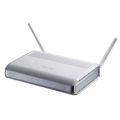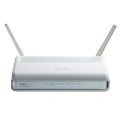ASUS RT-N12 rev A1
ASUS RT-N12 A1
Availability: common
FCC approval date: 04 August 2009
Country of manuf.: China
Type: wireless router
FCC ID: MSQ-RTN12
IC ID: 3568A-RTN12
Power: 12 VDC, 1 A
Connector type: barrel
CPU1: Broadcom BCM4716B0 (300 MHz)
FLA1: 4 MiB4,194,304 B <br />32,768 Kib <br />4,096 KiB <br />32 Mib <br />0.00391 GiB <br /> (Macronix MX25L3205D)
RAM1: 32 MiB33,554,432 B <br />262,144 Kib <br />32,768 KiB <br />256 Mib <br />0.0313 GiB <br /> (Samsung K4H561638H-LCCC)
Expansion IFs: none specified
Serial: yes, 4-pin header
WI1 chip1: Broadcom BCM4716B0
WI1 802dot11 protocols: bgn
WI1 MIMO config: 2x2:2
WI1 antenna connector: RP-SMA
ETH chip1: Broadcom BCM4716B0
Switch: Broadcom BCM5325E
LAN speed: 100M
LAN ports: 4
WAN speed: 100M
WAN ports: 1
bgn
TPFirmware supported: DD-WRT • (List), FreshTomato • (List | DLs), Oleg-ng (wl500g) • (List), TomatoUSB • (List | DLs)
Default SSID: ASUS (97 addl. devices)
Default IP address: 192.168.1.1
the IP 192.168.1.1 is used by 1310 additional devices
of which 168 are ASUS devices
Default login user: admin
Default login password: admin
admin:admin credentials used by 1331 additional devices
of which 200 are ASUS devices
802dot11 OUI: 14:DA:E9 (2 E, 2 W), BC:AE:C5 (4 E, 4 W)
Ethernet OUI: 14:DA:E9 (2 E, 2 W), BC:AE:C5 (4 E, 4 W)
| CPU1 brand | WI1 chip1 brand | WI1 chip2 brand | |
|---|---|---|---|
| ASUS RT-N12 rev A1 | Broadcom | Broadcom | |
| ASUS RT-N12 rev B1 | Broadcom | Broadcom | |
| ASUS RT-N12 rev C1 | Broadcom | Broadcom | |
| ASUS RT-N12 rev D1 | Broadcom | Broadcom | |
| ASUS RT-N12K | Broadcom | Broadcom | |
| ASUS RT-N12VP | Broadcom | Broadcom |
For a list of all currently documented Broadcom chipsets with specifications, see Broadcom.
Wireless N300 Router
Features
- SuperSpeedN:
- Up to 300Mbps data rate, suitable for seamless multimedia stream
- 4-Network-in-1:
- Provide extra network for prioritized bandwidth and access control
- Hardware EZ Switch for router, repeater and AP mode quickly changing
- EZ Switch: Switch your operation mode only ONE-Touch
- CD-Free Installation and Manual-Free Management
- 30,000 sessions for stable P2P download
Specifications
- Product Segment: N300 complete networking
- Antenna: 2x detachable dipole antenna
- Operating Frequency: 2.4GHz
- Button: WPS Button, Reset Button
- Ports:
- WAN: 1x FE (RJ45) for 10/100 BaseT
- LAN: 4x FE (RJ45) for 10/100 BaseT
- Power Supply:
- AC Input : 110V~240V (50~60Hz)
- DC Output : 12V with max. 1A current
- Dimensions: 179mm x 119mm x 37mm (WxDxH)
- Weight: 300g
Links of Interest
Hardware Modification
Flashing
| NOTE: During configuration or flashing a device, the only things that should be hooked to the device is the computer and power. |
Flashing DD-WRT
- • Installation instructions
| WARNING: Do not flash micro this unit! |
| WARNING: Requires K2.6 for DD-WRT, Do not flash anything else! |
DO NOT use Firefox for upgrading builds! Use Internet Explorer!
- Download the firmware dd-wrt.v24-14929_NEWD-2_K2.6_mini_RT-N12.trx.
- For simplicity, connect only the PC to one of the router's LAN ports with a normal [uplink] ethernet cable. No other modem,computers,routers,switches, etc should be connected.
- In order to prevent DHCP from interupting the connection, you will need to manually set the address of your PC's Network LAN card to a STATIC IP in the same subnet of the router, such as 192.168.1.10 with subnet mask 255.255.255.0 . Also make sure all other adapters,such as wireless, which might be seen as "clients" by the router are disabled. Only the main LAN connection [IP: 192.168.1.10] should be able to communicate with the router.
- Unplug the power connector from the back of the router.
- While pushing & holding the recessed Restore button on the back of the router, plug the power connector back in. The Restore button is NOT the raised red WPS button.
- When the power LED slowly blinks on and off, release the Restore button. The router is now in "RESCUE MODE".
- Use the Asus Firmware Restoration Utility [which you should have installed on the PC] to upload the DD-WRT mini-asus.trx file from the location where you saved it.
- DO NOT DISTURB THE ROUTER or PC FOR THE NEXT FEW MINUTES. BE PATIENT!
- After the upgrade, the Utility should ask for a router reboot. Give it AT LEAST a minute to be on the safe side before removing the power. Then unplug the power from the router, wait 10 seconds or so and plug the power back in. You should now be able to access the web interface.
- Return your Net adapter properties for TCP/IP to DHCP "Automatically Obtain IP"
- Type 192.168.1.1 into your browser and set your username as root and pick a password.
ALTERNATE INSTALLATION METHOD FOR ASUS TO DD-WRT FW UPDATE
- The steps listed above did not work for me, but these steps did.
- Disconnect all ethernet cables from the RT-N12 except 1 going to your NIC.
- Turn off all wireless clients (notebooks, PS3 etc...)
- Ensure DHCP is enabled in the ASUS firmware and retreive IP/DNS automatically is set in your NIC properties.
- (When you open your IE browser it will instruct you to plug back in your WAN ISP cable, if your PC is still seeing the router. If not, you may need to reboot router and/or PC.)
- Do the 30/30/30 peacock method of putting your router in recovery mode.
- Open the router IP of 192.168.1.1. The page will open to a built in browser (HTTP) recovery console.
- Click on the link Reboot to reset/flash the Vram.
- Click the Browse button to browse to your DD-WRT firmware file location.
- Click the Upload button.
- The router will upload the file fairly quickly, and you will be brought to the next screen that says "Allow router time to reboot." BE PATIENT this takes about 4–5 minutes. You will see the LAN1 light turn off and notice the "Network Cable Unplugged" windows popup message in task bar. Wait for the light to turn back on and the PC to reconnect to router.
- Click the "Continue" link shown on the page.
- Clicking "Continue" forces the router to perform another reboot. When it comes back up you will be at the DD-WRT admin login screen.
- If the login screen is white and looks very basic you will need to perform another reboot of the router by removing the power cable.
TomatoUSB
- • Asus Tomato Flash Guide
Note: some people say you need to install DD-WRT first. I do NOT recommend anyone to install DD-WRT first before installing Tomato on Asus routers.
- Download a suitable tomato firmware
- Install the Asus router utility from the CD that came with the router. Run \Utility\setup.exe from the CD to install it. If you no longer have the CD you can also download it from the Asus website.
- Disable Firewall on your computer.
- Disable anti-virus on your computer.
- Connect your computer to one of the LAN ports of the router with an ethernet cable.
- Assign a static IP of 192.168.1.10 and subnet mask 255.255.255.0 to your computer LAN port.
- Disconnect the router WAN port if you already have a cable plugged into that port.
- From Windows Start menu, run ASUS Utility -> RT-N Wireless Router -> Firmware Restoration.
- Click the Browse button and select the file that you downloaded in step #1. Don’t click the upload button yet.
- Put the router in recovery mode: Unplug the power cord of the router. Hold down the black Restore button using a pen (not the red button). Plug the power cord back in. Once the power light starts flashing slowing, release the Restore button. The power light should continue to flash. The flashing light means the router is ready to accept the new firmware in recovery mode.
- Click the upload button in the Restoration utility. If it warns about incorrect Asus firmware, ignore it. The firmware should now start uploading into the router. Don’t touch anything while the firmware is being uploaded. (Note: these steps worked when I flashed my RT-N16. However, the utility could not find my RT-N12 B1 when I tried to flash the router, although it did work for other people. After failing for more than a dozen times, I tried to perform the upload first before putting the router in recovery mode, then it finally worked. Later I tried a different unit of RT-N12 B1 strangely it could be flashed the first time using the normal procedure. If neither of these procedures work, please see the Addendum in The Wiert Corner, and the tftp method described by Simeon W in the comments section.)
- No matter whether the utility says the upload is completed, or it hangs at a certain percent, DO NOT PANIC, and WAIT FOR FIVE MINUTES before you do anything else.
- After five minutes, open a browser and go to http://192.168.1.1. Login with user “admin” (or “root”) and password “admin”. You should be logged into Tomato.
- Administration -> Configuration -> Restore Default Configuration -> Erase all data in NVRAM memory(thorough) -> OK (Note: there is a forum report saying this reset function does not work properly on RT-N53 – in this case, try the hardware reset button.)
- After it is completed, login again, enable DHCP (for Toastman Builds), change admin password, enable WiFi security if you use WiFi, plug in your WAN connection and configure it. Also take a look at the CPU frequency, you may need to manually change it if it is not correct. (Note: overclocking your router is usually not a good idea from my experience.)
- Change your computer LAN port back to use DHCP (dynamic address) and dynamic DNS.
Wiert Corner method
- pull the power plug on the RT N66U
- press and hold the reset button
- insert the power plug on the RT N66U
- wait for the power led to slowly blink
- release the reset button
- wait a few minutes for the modem to become stable
- in the mean time set your PC to these IPv4 settings: – host =
192.168.1.100– mask =255.255.255.0 - start your web-browser
- point your web-browser to
http://192.168.1.1(it will time out, don’t worry) - press the power button to turn off the router
- wait a few seconds
- press the power button to turn on the router now your router gets into rescue mode
- refresh your browser so it goes to
http://192.168.1.1again - upload your Tomato firmware
–jeroen
TFTP method
Put the router into recovery mode, set a static IP address on the computer then run in the shell:
tftp 192.168.1.1 binary put [filename].trx
Wait several minutes while firmware transfers and router updates. Reboot twice, waiting 3 minutes
- in between each reboot, and the router should now have tomato installed.
Images






















